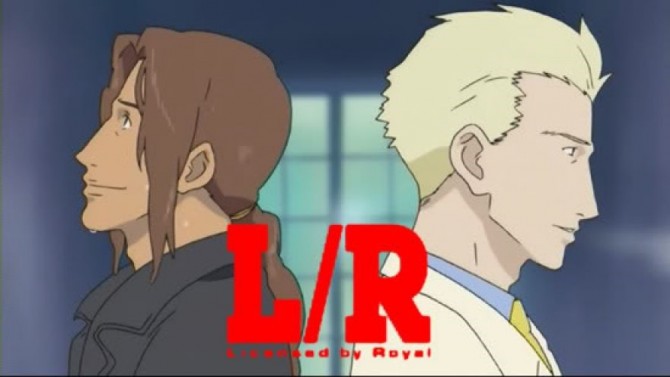November 22nd, 2013 in Anime, General Reviews, Short Run Series by The Droid

I debated whether to consider this a short-run series. It comes in at 11 shows, but that last one is a kind of recap, clip show, overview of things and seems more like a send-off than a real episode, although I do consider series runs of 11 or less a short-run. We’ll let you decide.
This is a very odd show. Odd in the sense that every character in this show is quite intelligent, learned, educated and knowledgeable on a variety of issues. Because of that, the show can get a little prolix and overly scholastic, as you learn the history of cocktails, the stories behind many famous drinks and what it is a bartender really does.
We are in the Ginza, a very popular area of Tokyo, where all sorts of bars and watering holes exist. But there is a very hard to find one, Eden Hall, where you go to for more than a mere libation, but a chance to reflect upon your life and where you want it to go. The man behind the bar, Ryū Sasakura, is a bartending prodigy who is said to mix the best concoctions anyone has ever tasted. But that is because he knows what it is you really need before you do and it isn’t merely booze, but both a tonic to revive and a statement to bring your life into focus.
Tags: Drama, Seinen, Slice of Life
November 17th, 2013 in Anime, General Reviews by The Droid

I have spoken about fan service a lot and that I sometimes feel that it goes overboard way too soon and it wrecks the flow and feel of the show. “Colorful” embraces our inner ecchi pervert to delightful ends and makes no bones about it.
Now, be careful, as there is a movie out there called “Colorful” as well. So how can you tell the difference? If you see panties on the cover, THIS is the one you want. If you see a boy in a school uniform, surrounded by flowers, that is NOT the one.
There are some disjointed story lines in this all-too-brief series, done more as blackout sketch comedy. Although the series has 16 episodes, nothing runs over 10 minutes, as we have numerous vignettes of guys getting their perv on to varying degrees of success. There are lots of shots of looking up skirts and peering down cleavage and way-too-tight blouses with bosoms bursting outwards and very pretty girls, all sexy in an innocent way. (more…)
November 15th, 2013 in Anime, General Reviews by The Droid

Now, I haven’t been actively watching anime for too long (at a mere 10 years, I am a youngling compared to others), but I have to say that 2013 has been a very exciting year. Sure, there have been a few duds, but the standout shows really stand out, like this one, “Psycho-Pass”.
It is the real future, as it is now 2116 (most ‘future’ shows are like 2040 or 2051, years that I have an outside chance of getting to see, only to discover there are STILL no flying cars). Don’t let the open throw you. Aside from it trying to look like “Blade Runner”, the opening fight is something that will occur about two-thirds into the series run, so just let it wash over you until you get into the actual story.
Tokyo is a utopia of harmony and understanding, sympathy and trust abounding; the dawning of the Age of Aquarius. Crime is almost non-existent, owing to this Sibyl System. You can kind of think of this world as ‘Minority Report’, but without Tom Cruise. People’s emotional state is measured by their Hue. Stress certainly plays into this assessment, done by the multiplicity of tracking cameras and Drones that patrol the streets. (more…)
Tags: Action, Police, Sci-Fi
November 8th, 2013 in Anime, General Reviews by The Droid

This is another strange show, in that you do not realize how all the stories are interconnected, as well as not getting the answers you need to understand what is going on, so it is going to take some dedication in viewing it. OK, the full title for this is “Mawaru Penguindrum”; otherwise, you may have a hard time finding it as merely ‘Penguin Drum”.
Initially, we drop in on the Takakura family, currently composed of (left to right) Kanba (the playboy type), Shoma (the innocent one) and Himari (the terminally ill one). Mom and Dad are missing (and we’ll find out why later in the series), so it’s just these three and the mysterious Uncle Ikeba (just a voice on the phone).
One day, they decide to go to the aquarium, where they purchase this really ugly penguin hat for Himari. As they are paying for the hat, Himari collapses. She is taken to the hospital, where she dies. As the brothers mourn, they are surprised to see Himari suddenly spring back to life, fully cured of her condition. The doctor calls it a miracle, as her condition was such that no one comes back, much less gets cured. (more…)
Tags: Comedy, Drama, Mystery, Psychological
November 6th, 2013 in Anime, General Reviews by The Droid

Well, I am a hopeless mermaid fanatic, but I knew that the world of “Mermaid Forest” I was getting myself into was not the realm of music and light and Ariel singing to me and combing her hair with a dinglehopper and wondering about legs. Sure, there’s lots of red to be seen, but it’s blood. This may be one of the bloodiest series I have seen in a while and I’m watching “Attack on Titan”.
Let’s start at the very beginning, a very good place to start. Yuta appears to be any other kind of wanderer in Japan (and let’s face it, Japan is loaded with them. I mean, Ash in ‘Pokemon’ is a 10-year old boy wandering all over hither and thither, so it’s not all that strange), except he has both a dark secret and a darker agenda. He is headed towards a remote village where he hears there are mermaids. The other islanders give it a hearty chuckle, ho ho ho. Why, they’ve been working these waters for years and heard the tales, but they gave it no heed. It’s just a rumor, like a balanced budget or an honest lawyer. (more…)
Tags: Drama, Fantasy, Horror, Mystery
November 2nd, 2013 in Anime, General Reviews by The Droid

This is a different kind of spy series, in more that they are secret agents, but certainly act like spies. Also, it is set in an alternative universe, but you are not certain what the year should be. I mean, they have zeppelins and wide screen HDTVs. Also, they speak with an English accent, drive what appears to be an MG, have tea at 4 pm, but we are not in England. We are in Ishtar (no, not that horrid movie with Dustin Hoffman and Warren Beatty), but it might as well be Jolly Olde England.
Our two heroes up there, Rowe Rickenbacker and Jack Hofner are L/R. The running joke is “Which one of you is ‘L’ and which one is ‘R’?” (Personal opinion, most of the time we see them left to right with Jack as the left and Rowe as the right, so I feel that is the real designation. Not that it REALLY matters).
Some of their tasks include the protection of royal artifacts and treasures from greedy individuals and stopping crimes against the Crown, although the main thrust of the story is to find the 15-Year Princess. It seems that the previous rulers of Ishtar came to a bad end, and the very young princess went missing in the ensuing scandal. The Crown wishes to find her and let her be the true ruler of England Ishtar. I will also not draw any conclusions that with Ishtar representing England, then the land of Ivory is to be Ireland, but that is open for you to determine. Personally, I am not a fan of symbolism or political commentary in my shows; I prefer to let them tell a good story. (more…)
Tags: Action, Adventure, Mystery
October 29th, 2013 in Anime, General Reviews by The Droid

I have noticed, as of late, a trend in anime shows to have what I call the “Join a Club” movement. These are shows where the person in question is forced or compelled or enticed or blackmailed into joining a club or they will have to face some kind of dire wrath for their failure not to sign up (as you might end up in the Flower Arranging Club instead).
The “Good Job Club” tells the tale of Kyōya Shinomiya (that guy down there), who gets kidnapped by the club, as they are on the verge of losing their accreditation, owing to the problem that they do not have enough members. He makes it five and they can be saved. The sole purpose of the club is to do good deeds (or a ‘good job’) and help others, but it all seems to be observed more in the breach than in reality.
The other members of the club include:
Tamaki Kannazuki, green hair. She usually has a bag of chips with her and says she can eat anything and not get fat.
Megumi Amatsuka, with the tea pot. She is constantly making tea for everyone, but flips out if someone says she is gaining weight. (more…)
Tags: Comedy, School, Slice of Life
October 27th, 2013 in Anime, General Reviews, Short Pull Series by The Droid

“Yami Shibai: Japanese Ghost Stories” (also known as “Theater of Darkness”) is a short-pull series, as none of the episodes go over five minutes. For those who remember, this is more like “Night Gallery”, in which a short tale is told and there is some kind of ironic twist at the end, but something bad happens to the person in question.
This is a show with not only limited animation, but it is a caliber of stop-motion. This approach may be off-putting to some, as it really is an ‘economical’ approach to animation that may or may not work. The stories themselves may also be too brief to generate any real scares, not much different than tales around the campfire, done so I can make you drop your marshmallow into the flames.
It opens with a bunch of kids at a playground, but they are not playing. They are waiting. But waiting for whom? The ice cream man? The Octopus Ball woman? The friendly neighborhood dope peddler? Nope, it’s this guy on his bike, lugging his little shrine. The kids cluster around him and he tells another tale of terror and torment. (more…)
Tags: Horror, Supernatural
October 22nd, 2013 in Anime, Featured, General Reviews by The Droid

When I heard that this show had reached its coupler point, I line-jumped eight other reviews I had in front of it to get the news to you:
“Attack on Titan” is the MUST-SEE anime of 2013.
Now, I do not allow myself to be overtaken with hyperbole and CAPITAL LETTERS to get your attention on what is out there. Many shows come out every year that are worthy of your attention, but “Titan” is head and shoulders above the rest (no pun intended). The last time I was this jazzed about an anime was “Death Note”, and they both share similarities, the biggest being that it cannot be pigeon-holed into what it is and must be experienced to see what the buzz is all about.
OK, enough of my drooling, mouth-panting excitement, let’s get down to brass tacks.
It is the year 845. For the past hundred years, giant humanoid creatures called Titans have forced humanity to retreat into a system of concentric walls known as Wall Maria (outermost), Wall Rosé, (middle), and Wall Sina (innermost). Inside these walls, humanity has lived in peace. These are massive walls, at least 50 meters tall and potentially 10 meters thick, maybe more. Mankind survives, but at what real cost? One day, they are attacked by a 60-meter Titan (as he can look over the wall to see what’s happening) and some armored-skinned Titan who breaches the wall and allows the other Titans to enter and attack. (more…)
Tags: Action, Drama, Fantasy, Super Power
October 20th, 2013 in Anime, General Reviews by The Droid

This starts out as an entry in the ‘nothing’ show category, as it is nothing more than a series of disconnected stories and tales that sometimes have no point, regaling in the strangeness that life has to offer.
When it was a manga, it was called “Regular Life”, but when it became an anime, it turned into “My Ordinary Life”, and is highly reminiscent of “Daily Life of High School Boys”, in that we see these events and you can watch the show out of order or miss an episode and you do not miss (that) much.
The tales are broken into two portions: school life and laboratory life. The school life segments involve Mai Minikami (Slot 1) who is very intelligent, but very quiet, Yuko Aioi (Slot 2) who is always forgetting to do her homework or forgetting to bring her homework if, by some rare confluence of time and space, she has managed to actually do it and Mio Naganohara (Slot 4) who is a manga artist, but doesn’t want people to know this. We see them go through the paces of being in school. The three of them have a caliber of relationship as was seen in “Kill Me, Baby” (minus the physical mayhem) but it is played for strangeness, as when Yuko is sent into the hall for not doing her homework and sees the vice-principal have a wrestling match with a deer that has come on campus. (more…)
Tags: Comedy, School, Slice of Life









